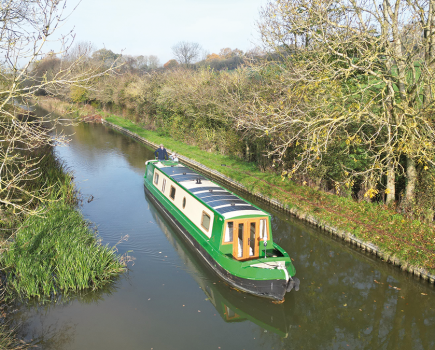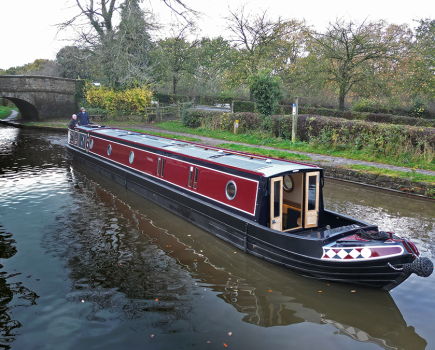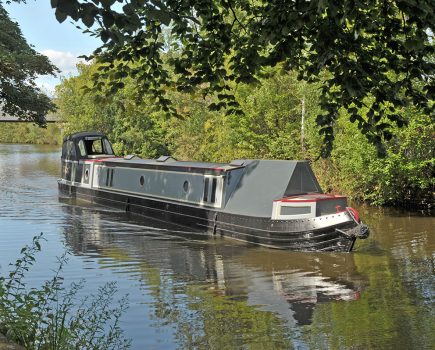Simpsons Boats 50ft
SIMPSONS BOATS 50ft
Voted favourite boat at this year’s (2006) Crick show, Simpsons Boats Shoehorn has been carefully designed and built to suit its owner’s needs – and the clue is in the name.Walking round the Crick Show earlier this summer it was easy to see a certain ‘sameness’ in a lot of the boats. In fact, one colleague remarked: “It was a bit like looking at a lot of Ford Mondeos – different colours, different equipment, but the same basic car underneath.” Maybe a slight exaggeration but you can see his point.And so, perhaps, did the visitors for they voted as their favourite boat at the show one which very definitely did not run with the crowd – Shoehorn from Simpsons Boats. The company won the same award two years ago but a lot of water has passed under the bridge since then – it has new owners, new premises and a largely new workforce. Crick 2006 was its first public chance to show what they could do and it was clearly an impressive debut.DESIGN AND EXTERIORMany boats claim to be ‘bespoke’ these days but few go as far down the made-to-measure route as Shoehorn which was designed both as a live-aboard for its owner, Marion Parish, and for the canal on which she will keep the boat.The Mon & Brec canal is a delightful, scenic waterway running up into mid-Wales. Though being restored and extended, it remains for the moment an isolated canal. And a tricky one. There are several low bridges, some tight turns and the canal itself is quite shallow, especially near the banks.All these features determined the key elements of Shoehorn’s design. To begin with, it’s just 50 feet long, to aid manoeuvrability through the turns. (And is also fitted with bow thrusters for the same reason.)The Jonathan Wilson built trad-stern shell is also four inches lower than normal, two inches having been lost from the hull and two taken off the cabin height.Finally, instead of being flat-bottomed, the hull has a shallow vee-section under water to improve clearance at the shallow canal edges.Once these basic parameters had been established, all Simpsons had to do was devise practical and comfortable live-aboard accommodation for Marion in a space ten feet (or even more) shorter than usual – hence the name Shoehorn!The resulting configuration is a conventional one – forward saloon leading to galley, full width bathroom and rear cabin – but the stylish and clever execution is what appealed to the crowds at Crick.SALOON
One of the most noticeable features of Shoehorn is that, despite its dimensions, it exudes a real feeling of space. This is immediately apparent in the saloon which contrives to feel wide as well as more than amply long.The most obvious reason why is that a two-seater sofa has been ranged crossways against the front of the galley units behind so that occupants look forwards along the length of the saloon rather than, as is often the case, across the narrow width of the boat.Less immediately obvious is the contribution made by the fitting out of Shoehorn. The good-looking floor is nine-inch wide planks of reclaimed English oak, whose width again broadens the feel of the boat. Lining out is in European oak veneered ply (chosen over American oak for its most interesting grain patterns) with solid oak trims. Here, too, the unusual roof lining design, with full length strips either side of regularly cross-ribbed centre panels makes the cabin feel wider. Incidentally, the reduced headroom was not apparent to either writer or photographer during the test.Centrepiece of the saloon is the delightful and intricate Petit Godin multi-fuel stove, chosen for its compact dimensions as well as its good looks. Its ornate top hinges up to reveal a handy hotplate surface. Heat protection around the stove is by unobtrusive black painted steel panels rather than tiles.Sensibly, the saloon has been kept as free from intrusion as possible. There’s a shallow set of shelves on the starboard side which also holds a flat-screen TV that can be swung out for viewing from the sofa and this curves into a corner cupboard in which are the DVD and hi-fi. Finally the oak steps from the front deck hinge up as a unit to provide more storage underneath.The cupboard has an arched door that was a traditional Simpsons’ hallmark. It like some of the other interior joinery on the boat is made from MDF – a material favoured in many areas because it can be cut to intricate shapes and is very stable (it won’t warp or split). However, it does deteriorate when wet so its use on boats has been questioned. Simpsons say they only use it for interior work where it should get no more damp than in typical domestic use (for example in many high-quality custom kitchens). All the same the company now offers customers the option of ‘real’ wood alternatives.Given the compact overall dimensions of the boat, full use has been made of the short front deck to extend living space with a cratch and cover. The cratch is fully glazed, as are the cover sides to create a really well lit space. The double oak doors leading to the saloon and the panels either side of them are all two-thirds glazed so the saloon can also benefit from this light. Push-in pads rather than curtains are used at night.
GALLEY
The galley has another of the boat’s design innovations to get the most from its space and at the same time solve two familiar problems – where to put the rubbish bin and how to deal with the ‘dead’ corner left in the commonly used L-section arrangement of galley units.Shoehorn’s galley comprises such an ‘L’ arrangement on the port side, in which are housed the main appliances, with a short straight run opposite. Curved ends to the surfaces sweep the gangway into the galley in a gentle ‘S’ while the central exit to the rear is through another company trademark, the central archway.The area is well lit, with windows either side, a Houdini hatch and a side hatch. Flooring changes from boards to light coloured tiles as you enter the galley.The work surfaces are in slim oblong limestone tiles, again reflecting light, laid diagonally to help build the sense of space and edged with oak trims. The surfaces have also been narrowed very slightly to maximise gangway space.Under the starboard worktop is a washer/drier as well as a set of pull-out baskets. The port side holds a Spinflo gas cooker, grill and four burner hob and ahead of it a double bowl sink whose mixer tap can also supply filtered water – turning a small lever sources water from the under-surface cassette filter. Ahead of the sink is a free standing fridge. Turning the corner one comes to a large set of drawers.In the corner of the work surface sits a chopping block. This flips up to reveal the waste bin underneath in that dead corner and – here’s the clever bit – this is accessed for emptying by rolling out the drawer unit across to the starboard side of the boat.It’s a neat idea, using the dead space, hiding away the waste bin, creating some useful extra workspace and, if you need to, closing off the galley from dogs and children (or simply too many cooks!).In practice we found it rather hard to use – despite being on castors, the drawer unit is heavy to pull out or push back, especially if the boat isn’t dead flat in the water. But it’s very much a prototype and the firm intends to refine the idea in the future, probably by re-positioning some of the kitchen units. (Perhaps swapping the drawers for the basket units.)Main food storage for the boat is in a tall pull-out larder unit built into the arch at the rear of the galley. There’s a small glass store above this. Opposite in the archway are shelves that carry crockery.
BATHROOM
The full width bathroom would impress anywhere – it was certainly larger than the en-suite in my Holiday Inn bedroom the night before! However, its most noticeable feature is not its size but the large and, to be honest, not very pretty Envirolet composting toilet immediately on the starboard side as one enters from the galley.The toilet was Marion’s choice and, if you can get over the notion of a W.C. without any W, it has a lot going for it on a boat – chiefly that a single live-aboard boater will probably only have to empty it once a year and then what comes out is a tray of flowerpot ready compost. Compare that with expensive pump-outs or weekly cassette emptying!In regular use, it is aerated daily with a simple lever. A flue and quiet, low-power electric fan which runs constantly when in use ensure there are no smells in the toilet (and there should be very little smell anyway, even outside, if the system is running properly). In normal use water evaporates off but a party of beer drinkers might have to make, er, other arrangements.The Envirolet, sold in the UK by Whilton Chandlery, comes from Canada where it’s used in backwoods cabins. Main problem in adapting it to use in Shoehorn was its bulk – the flue and some of the machine itself are hidden in the archway behind the crockery shelves. It’s not pretty either (Simpsons are encouraging the company to think about a better looking boat version) and it’s costly at �1375 (though there’s no holding tank and no pump-out charges, remember).Across the boat from the toilet is a bowl style basin on an open stand (again, to keep the sense of space) and at the rear of the room is a very sizeable 900mm x 600mm shower cabinet, specially made for the boat because of the reduced headroom, and lined with ‘wet wall’ – a plastic surfaced HDF material.
CABIN
A door on the starboard side, with full height mirror on the cabin face, leads through into another clever piece of ‘shoehorning’ – a raised cabin bed. This is such a practical feature that it’s surprising it isn’t seen more often. Raising the bed has allowed three tiers of drawers to be built underneath – two with pairs of deep drawers and the third with three shallower drawers.Most of the drawers are almost full bed width and have a double runner arrangement so they can be slid out in two stages to reach right to the back. The forward drawers are shallower and can be removed for access to the calorifier behind. The solid oak drawers make a handsome piece of ‘furniture’ too, having chrome handles and what looks like a step to help one up into bed – it’s actually a fender eye and getting up onto the bed, while not hard, is easiest via one of the rear steps.As well as the drawers, the cabin has a small locker over the bed head, which also carries speakers that are linked to the sound system in the saloon, and a good size wardrobe that drops down to the swim for full-length storage.Opposite the wardrobe, steps lead up to the rear deck, passing a wet locker to port which also holds the header tanks and the electric systems panel to starboard.
TECHNICAL
Shoehorn has a relatively modest engine – a 35hp, three cylinder Barrus Shire – but one that is clearly perfectly adequate for its size and location. It was tidily installed in the boat though still under temporary engine bay covers – they are due to be replaced with T-section hardwood stretchers supporting hardwood floor panels to create a good looking and easily removable floor.The batteries – one engine start battery and three deep cycle 135 aH leisure batteries – are located on the aft portside swim.Though Shoehorn is a liveaboard, the owner is very energy conscious and so doesn’t have a large power requirement. The engine has twin alternators, a 110amp unit to charge the domestic battery bank and a 70amp unit for the engine and bow thruster batteries. A Sterling four step 20amp charger is used as well as a Sterling 1800watt inverter for 230v AC supply. There is also switchable shore power and the high demand washer/drier is wired to this circuit only. As well as the multi-fuel stove, there is Webasto central heating with radiators in the saloon and cabin plus a towel rail rad in the bathroom.
EXTERIOR
Shoehorn is a discreetly good-looking boat; its high-quality mid-blue Craftmaster paintwork set off by cream coachlines and smart chrome windows and fittings. Nice touches are the diamond pattern non-slip surfacing to the roof and the Welsh dragon created the same way in the roof hatch.Blacking is in two-pack epoxy – Marion opting for this longer life system because of the boat’s isolated location.
ON THE WATER
We spent more time manoeuvring Shoehorn around the tight confines of Pontypool canal basin than out in the cut but if we didn’t get a chance to extend the boat, we did get to see just what the problems of life on the Mon & Brec can be. The canal is shallow and the edges especially so (even with its vee-hull Shoehorn was aground at its mooring).The area round the basin is also typically tight, with a narrow, low, arched bridge immediately before the tight turn into the basin. Even with bow thrusters, winding was hard work – without one, near impossible without help from the bank – but that was no fault of the boat which was straightforward to handle.The engine was quite noisy when working hard like this but we’ll suspend judgement on that one as the flooring was temporary, otherwise the craft performed well.
CONCLUSION
Shoehorn is a very likeable boat. Not only does it never feel cramped in length, it also manages to feel wider and more roomy than many narrowboats. On top of this, it has a homely feel to it – the oak fit-out seems warmer and more relaxing than the currently fashionable ash.It has some very clever design features – we liked the cabin bed a lot, the bathroom is impressively roomy and the roll-out galley unit ingenious (we await the Mark Two version with interest). As for the Envirolet: it does make a lot of sense but the company does badly need to develop a more compact boating one.At nearly �90,000 for a 50 footer, it may look quite costly but a good portion of that cost is taken up with ‘extras’ such as the �1700 oak flooring, �1450 vee-hull, �1400 custom shower, �1375 toilet and �3000 bow thrusters. By way of comparison a ‘standard’ 58 footer from Simpsons costs around �80k.Overall, it’s an impressive craft, well worthy of its Crick award and a good demonstration that a truly bespoke boatbuilder can offer a lot more than just a choice of worktop colours.
Length: 50ft 0inBeam: 6ft 10inDraught: 2ft 6inSteelwork: 10:6:4Engine: Barrus Shire 3-cyl 35hp,Electrical: 12v DC, 220v AC via Sterling 1800w inverter + landline
Simpsons Boats
The Boat Shed
Brimscombe Port Ind Est.
Brimscombe
StroudGlos GL5 2QG
Tel: 01453 885850
Price: �89,950 inc VAT including electric bow thrusters, Envirolet toilet, custom shower, vee-hull www.simpsonsboats.com







